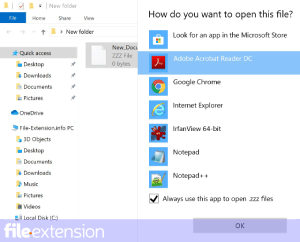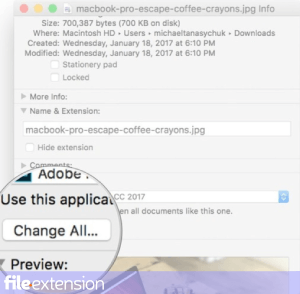
FILE File Extension
Generic Windows Format
-
Category
-
Popularity4.1 (22 votes)
What is FILE file?
FILE is a type of file generated by Windows operating system.
What content can I find in files with FILE extension?
FILE is a generic extension and is added by Windows automatically to file whose content type is unknown. In practice if system doesn't recognize a downloaded file or the file has no extension suffix, such file is saved with FILE suffix.
Can I open a FILE file?
Microsoft operating systems do not specify a default application to open a FILE file therefor attempts to open such file by double-clicking on will not work. Adding a FILE extension to a file doesn't change its original content, so user could try opening a FILE file in an application that they suspects might handle the file (for example, if given FILE file might have been a MP3 file, it could be opened with a music player).
Is opening FILE files safe?
Files with FILE extension from unknown sources could contain malicious software. Running an executable file whose extension has been intentionally changed to FILE may introduce a virus int the system. Therefore users should not open FILE files from unknown sources without prior inspection with an antivirus program.
Programs which support FILE file extension
Files with FILE extension, just like any other file formats, can be found on any operating system. The files in question may be transferred to other devices, be it mobile or stationary, yet not all systems may be capable of properly handling such files.
Updated: 12/08/2023
How to open file with FILE extension?
Being unable to open files with FILE extension can be have various origins. Fortunately, most common problems with FILE files can be solved without in-depth IT knowledge, and most importantly, in a matter of minutes. The list below will guide you through the process of addressing the encountered problem.
Step 1. Install Corresponding program software
 The most common reason for such problems is the lack of proper applications that supports FILE files installed on the system. To address this issue, go to the Corresponding program developer website, download the tool, and install it. It is that easy Above you will find a complete listing of programs that support FILE files, classified according to system platforms for which they are available. One of the most risk-free method of downloading software is using links provided by official distributors. Visit Corresponding program website and download the installer.
The most common reason for such problems is the lack of proper applications that supports FILE files installed on the system. To address this issue, go to the Corresponding program developer website, download the tool, and install it. It is that easy Above you will find a complete listing of programs that support FILE files, classified according to system platforms for which they are available. One of the most risk-free method of downloading software is using links provided by official distributors. Visit Corresponding program website and download the installer.
Step 2. Check the version of Corresponding program and update if needed
 If the problems with opening FILE files still occur even after installing Corresponding program, it is possible that you have an outdated version of the software. Check the developer’s website whether a newer version of Corresponding program is available. Sometimes software developers introduce new formats in place of that already supports along with newer versions of their applications. This can be one of the causes why FILE files are not compatible with Corresponding program. All of the file formats that were handled just fine by the previous versions of given program should be also possible to open using Corresponding program.
If the problems with opening FILE files still occur even after installing Corresponding program, it is possible that you have an outdated version of the software. Check the developer’s website whether a newer version of Corresponding program is available. Sometimes software developers introduce new formats in place of that already supports along with newer versions of their applications. This can be one of the causes why FILE files are not compatible with Corresponding program. All of the file formats that were handled just fine by the previous versions of given program should be also possible to open using Corresponding program.
Step 3. Assign Corresponding program to FILE files
If the issue has not been solved in the previous step, you should associate FILE files with latest version of Corresponding program you have installed on your device. The next step should pose no problems. The procedure is straightforward and largely system-independent

Change the default application in Windows
- Clicking the FILE with right mouse button will bring a menu from which you should select the option
- Select
- Finally select , point to the folder where Corresponding program is installed, check the Always use this app to open FILE files box and conform your selection by clicking button

Change the default application in Mac OS
- From the drop-down menu, accessed by clicking the file with FILE extension, select
- Open the section by clicking its name
- Select Corresponding program and click
- Finally, a This change will be applied to all files with FILE extension message should pop-up. Click button in order to confirm your choice.
Step 4. Ensure that the FILE file is complete and free of errors
Should the problem still occur after following steps 1-3, check if the FILE file is valid. It is probable that the file is corrupted and thus cannot be accessed.

1. Verify that the FILE in question is not infected with a computer virus
Should it happed that the FILE is infected with a virus, this may be that cause that prevents you from accessing it. It is advised to scan the system for viruses and malware as soon as possible or use an online antivirus scanner. If the FILE file is indeed infected follow the instructions below.
2. Verify that the FILE file’s structure is intact
If you obtained the problematic FILE file from a third party, ask them to supply you with another copy. The file might have been copied erroneously and the data lost integrity, which precludes from accessing the file. If the FILE file has been downloaded from the internet only partially, try to redownload it.
3. Verify whether your account has administrative rights
Some files require elevated access rights to open them. Switch to an account that has required privileges and try opening the Generic Windows Format file again.
4. Check whether your system can handle Corresponding program
If the systems has insufficient resources to open FILE files, try closing all currently running applications and try again.
5. Ensure that you have the latest drivers and system updates and patches installed
Latest versions of programs and drivers may help you solve problems with Generic Windows Format files and ensure security of your device and operating system. It is possible that one of the available system or driver updates may solve the problems with FILE files affecting older versions of given software.
Do you want to help?
If you have additional information about the FILE file, we will be grateful if you share it with our users. To do this, use the form here and send us your information on FILE file.

 Windows
Windows 
